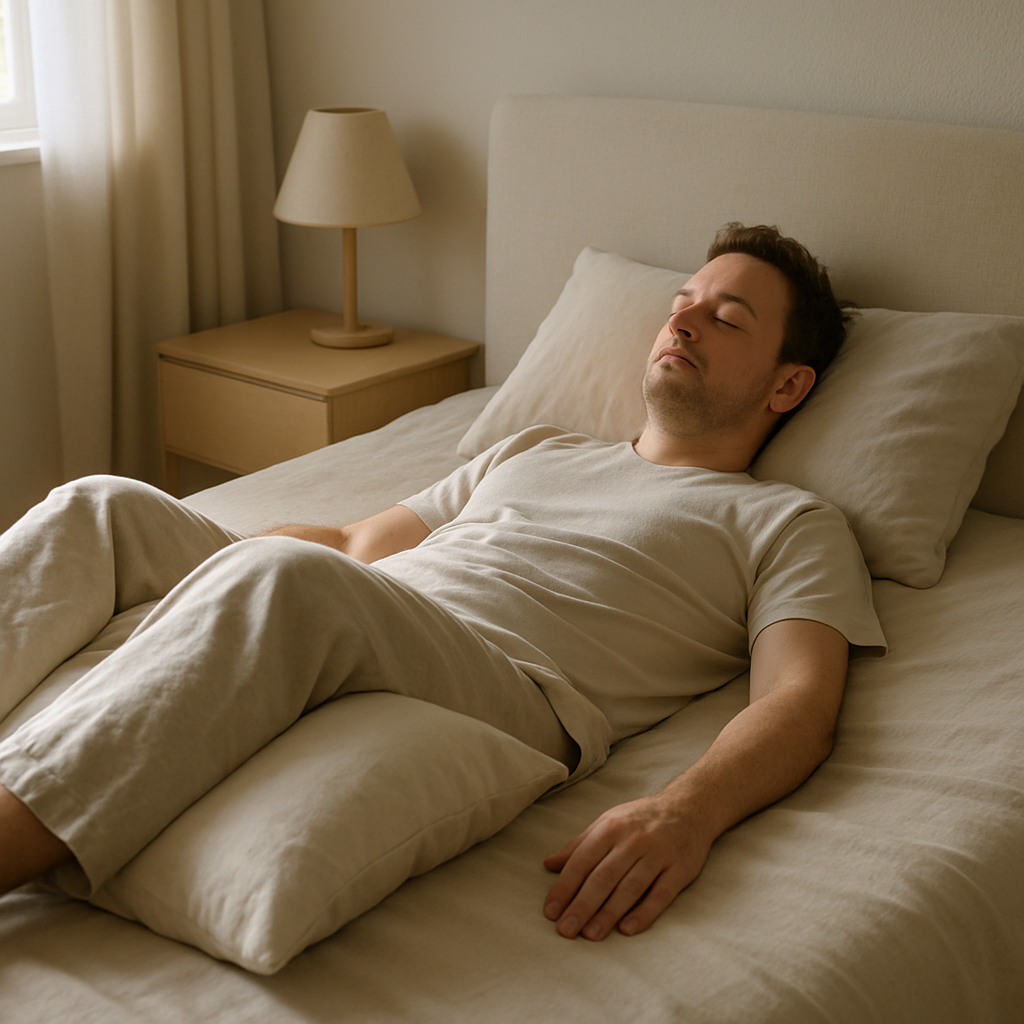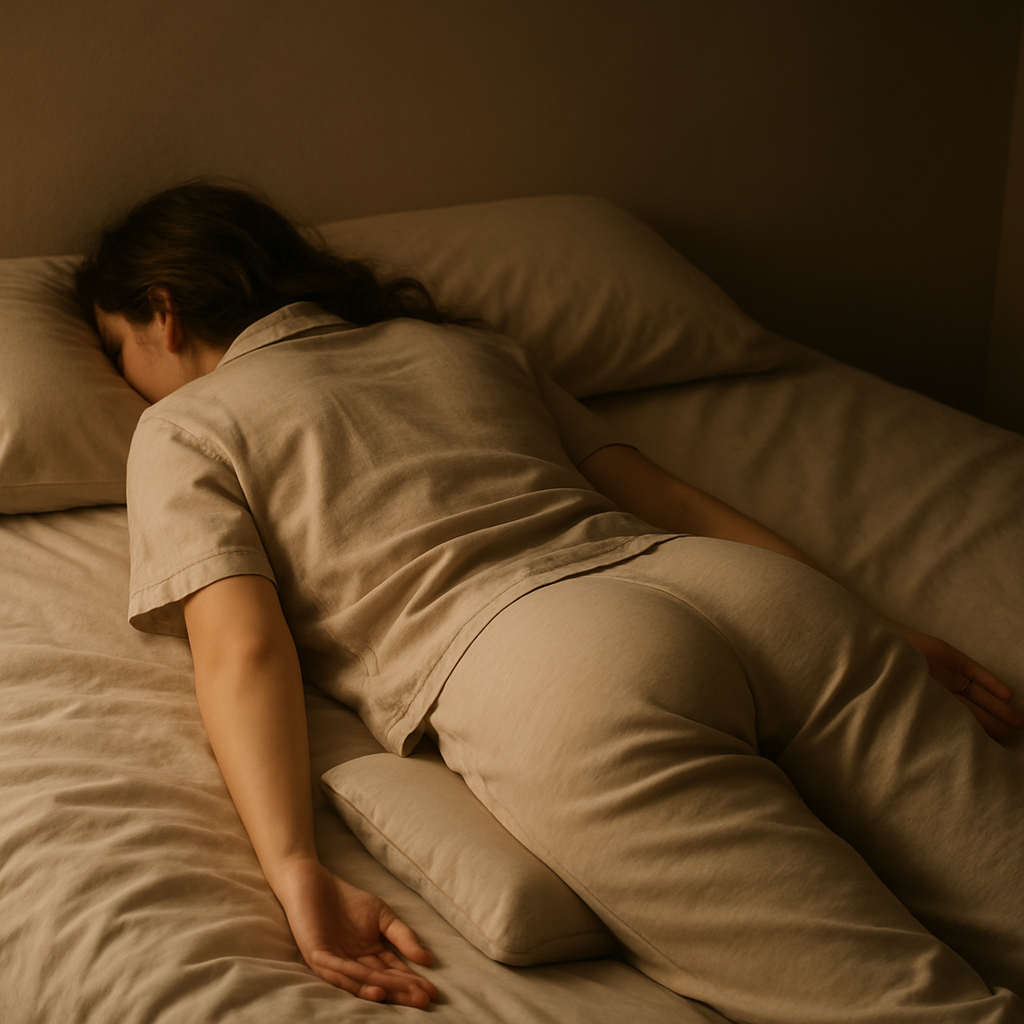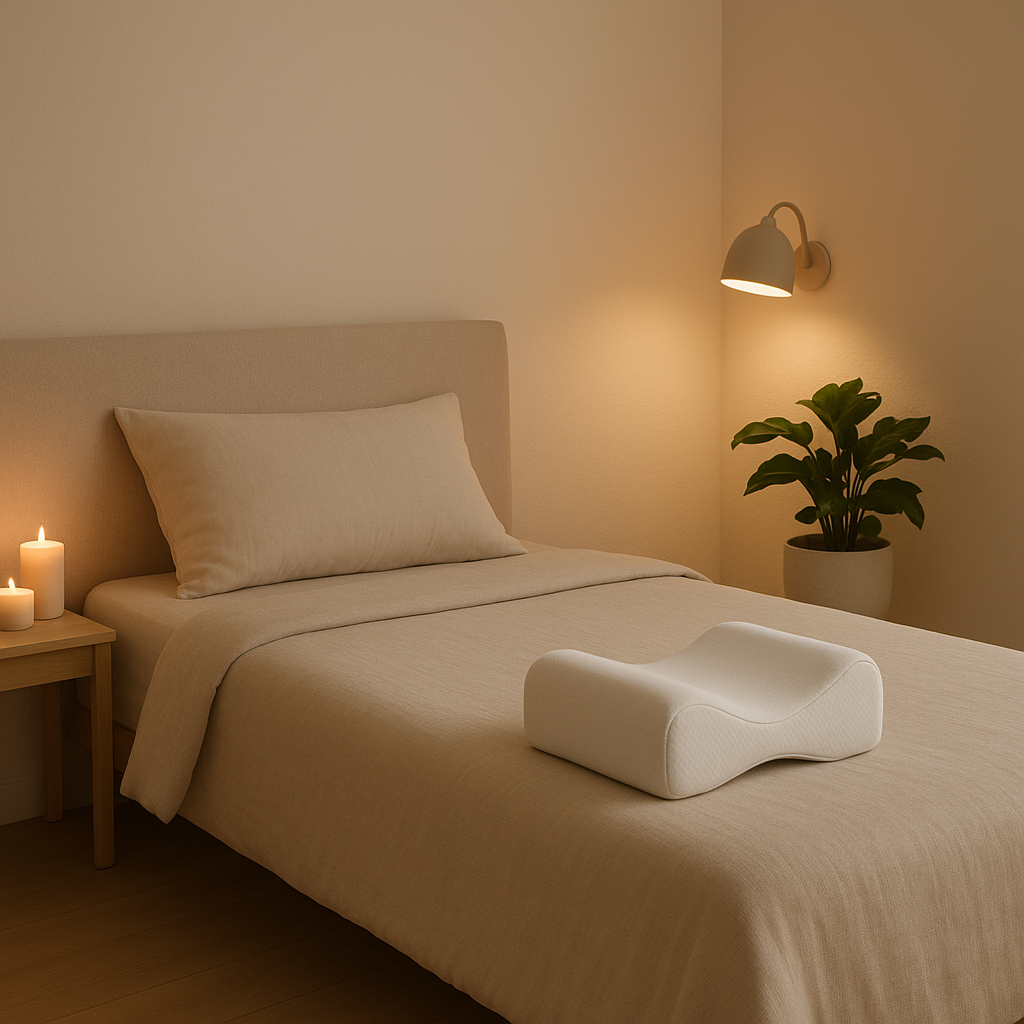
Have you ever found yourself shoving pillows under your legs, behind your back, or between your knees, all in a desperate bid to get comfortable? If so, you're not alone — and there's one small adjustment that might make a surprisingly big difference: sleeping with a pillow under your knees.
But does it really help, or is it just another sleep myth? The answer, backed by scientific research and sleep medicine experts, is that for many people, this simple trick can reduce back tension, improve spinal alignment, and even help you wake up feeling less stiff. Let's unpack how it works, when it helps most, and what sleep specialists really think about this small but mighty sleep tweak.

When you lie flat on your back, your spine naturally curves inward at the lower back, creating what's known as lumbar lordosis. If your legs are fully straight, that curve can sometimes tug on your back muscles and hip flexors overnight — especially if they're tight to begin with. This phenomenon has been studied extensively in biomechanical research, which shows that certain sleeping positions can significantly impact spinal alignment and muscle tension.
Research published in PLOS One examining relationships between sleep posture and spinal symptoms demonstrates that spinal alignment during sleep directly affects sleep quality and morning stiffness. The study found that maintaining neutral spinal positioning throughout the night reduces pressure on intervertebral discs and minimizes muscle strain.
Putting a pillow under your knees slightly bends them and tilts your pelvis just enough to help flatten that lumbar curve. The result? Less strain on your lower back while you sleep. This positioning works by reducing the pull of the psoas muscle, a deep hip flexor that connects the lumbar spine to the femur. When this muscle is shortened due to prolonged sitting or tight hip flexors, it can create excessive lumbar extension when lying supine.
Dr. Shiyan Yeo, an internal medicine physician and sleep medicine expert, explains it like this:
Supporting the knees can ease the pull on the lumbar spine. For many back sleepers, this simple position keeps the spine more neutral and reduces tension.
This expert opinion aligns with research from a comprehensive scoping review published in BMJ Open, which found that sleep positioning significantly impacts lower back pain intensity and sleep quality. The study tracked participants over several weeks and found that those who used supportive positioning aids reported improved sleep satisfaction and reduced morning back pain.
Put simply, a pillow under your knees helps your back stay in a healthier, more relaxed shape overnight — so those muscles don't stay tight and sore by morning. This is particularly important given that we spend approximately one-third of our lives in bed, making sleep positioning a critical factor in musculoskeletal health.

Here's why so many people keep this trick in their nightly routine, supported by both clinical observations and research findings:
Less pressure on the lower back: Research in Chiropractic & Manual Therapies shows that proper knee elevation can reduce lumbar pressure significantly compared to lying flat with straight legs.
Better spinal alignment: Studies using pressure mapping technology, including research published in BioMedical Engineering OnLine, demonstrate that knee elevation helps maintain the spine's natural S-curve, reducing stress on vertebral joints.
Relief for tight hips: The position helps lengthen hip flexors that have been shortened from prolonged sitting, which is particularly beneficial for office workers and those with sedentary lifestyles.
Sometimes fewer snoring issues: A slight knee bend can help keep your airways open if you're a back sleeper by slightly elevating the torso and reducing airway collapse.
Improved circulation: Elevating the legs can enhance venous return, reducing swelling in the lower extremities and improving overall circulation during sleep.
This simple position change can help if you fall into several categories that research has identified as most likely to benefit:
Back sleepers: Those who primarily sleep on their back are the ideal candidates for this technique. Research shows that back sleeping, while generally good for spinal alignment, can sometimes create lower back strain without proper support.
People with morning back stiffness: If you often wake up with back tightness, studies suggest this positioning can significantly reduce morning pain scores on standardized pain assessments.
Individuals with mild hip or pelvis discomfort: Research in Clinical Biomechanics indicates that hip flexor tightness is a common contributor to lower back pain, and knee elevation can help address this issue.
Post-surgical patients: Those recovering from certain back or hip surgeries (with their doctor's okay) often find this position helpful during the healing process. Always consult with your healthcare provider before making positioning changes during recovery.
Pregnant women: Later in pregnancy, this position can help reduce lower back strain, though side sleeping becomes more recommended as pregnancy progresses.
Office workers and those with sedentary jobs: People who sit for extended periods often develop tight hip flexors, making them prime candidates for this sleep positioning technique.
While the concept seems straightforward, small tweaks matter significantly for effectiveness:
Positioning: Lie on your back, knees gently bent. The angle should be comfortable and natural, typically around 20-30 degrees of knee flexion.
Pillow placement: Slide a supportive but soft pillow under your knees, not your thighs. The pillow should support the entire length of your lower legs from just below the knee to the ankle.
Height adjustment: Adjust the pillow's height so your knees bend naturally, without overdoing it. Research suggests that excessive elevation (more than 45 degrees) can actually create hip strain.
Too thick? It might strain your hips and create new pressure points. Too flat? Won't provide adequate support to achieve the biomechanical benefits. Many people prefer a medium pillow or a small bolster that maintains its shape throughout the night.
The key is finding the "Goldilocks zone" — just right for your body mechanics and comfort preferences. This may require some experimentation over several nights to determine the optimal pillow height and firmness.
If you're a side sleeper, a pillow under your knees won't help much — but putting one between them absolutely can. This is supported by extensive research on sleep positioning and spinal health.
Dr. Suzanne Gorovoy, a clinical psychologist specializing in behavioral sleep medicine, points out:
A pillow between your knees can stop your top leg from pulling your spine and hips out of line while you sleep. It's simple, but it often makes a big difference for side sleepers with hip or lower back pain.
Research published in Osteoarthritis and Cartilage confirms that side sleeping with proper knee support maintains better spinal alignment than unsupported side sleeping. The study used MRI imaging to show how pillow placement affects spinal curvature during sleep.
In short, that knee pillow keeps your hips stacked and your spine straighter, so you don't wake up feeling like you twisted yourself into a pretzel overnight. For side sleepers, consider exploring which side is best for sleeping positions to optimize your sleep setup further.

Stomach sleeping is generally tough on your neck and lower back — but some people can't drift off any other way. Research consistently shows that prone sleeping creates the most spinal stress, but modifications can help.
In that case, try sliding a thin pillow under your pelvis instead of your knees. This can help flatten the curve in your lower back, making it less stressful for your spine. Studies in PubMed research on lumbar lordosis demonstrate that pelvic support during prone sleeping can reduce lumbar extension and associated muscle tension.
However, it's worth noting that stomach sleeping is generally not recommended for optimal sleep quality and spinal health. If you're a committed stomach sleeper, consider gradually transitioning to side or back sleeping for better long-term outcomes.
There's no single right answer — but research and clinical experience suggest some pillows work better than others:
Medium, supportive standard pillow: Works for most people and provides adequate elevation without being too firm or too soft.
Small bolster or cylindrical pillow: Holds its shape nicely throughout the night and provides consistent support. Research shows that maintaining consistent elevation is important for sustained benefits.
Memory foam wedge: Can give more lift if you want extra elevation. Studies indicate that memory foam maintains its shape better than traditional pillow materials, providing more consistent support.
Contoured knee pillows: Specifically designed pillows that follow the natural shape of the legs can provide optimal support and are often recommended by physical therapists.
Dr. Michael Grandner, professor of neuroscience and sleep researcher, emphasizes:
The goal isn't just to stick a pillow anywhere — it's to support your natural posture so your back muscles aren't strained all night.
Research in Ergonomics journal supports this, showing that the pillow material and shape significantly impact pressure distribution and support effectiveness. The study found that pillows maintaining consistent elevation and shape throughout the night provided superior benefits compared to those that flattened or shifted position.
Some people like to take it further and use a wedge pillow or adjustable bed to lift their legs a bit more. Extra elevation can provide additional benefits, particularly for certain populations:
Reduce swelling in feet and ankles: Research in lymphatic studies shows that leg elevation improves lymphatic drainage and reduces peripheral edema.
Improve circulation: Studies demonstrate that elevating the legs above heart level enhances venous return, which is particularly beneficial for people who stand a lot or have circulation issues.
Ease pressure on the lower back even more: Additional elevation can further reduce lumbar pressure, though there's a point of diminishing returns as shown in research on lumbar support.
Support heart health: Research indicates that leg elevation can reduce cardiac workload by improving venous return efficiency.
Just make sure your knees stay bent naturally — you don't want to lock them straight, which can create circulation issues and joint stiffness. The optimal elevation angle, according to research, is typically 6-12 inches above heart level for circulation benefits, while maintaining comfortable knee flexion.
Like most sleep tweaks, this won't be a miracle for everyone. Research shows that individual responses to sleep positioning vary based on factors including:
Some people love it instantly. Others kick the pillow away by midnight because it feels awkward. Clinical studies show that it typically takes 3-7 nights for people to adapt to new sleep positioning, so persistence is important.
The only way to know? Try it for at least a week. Pay attention to how you feel in the morning — less back tension is usually a good sign it's doing its job. Keep a simple sleep diary to track your comfort levels and morning stiffness.
Research suggests that people with the following characteristics are more likely to benefit:
A pillow under your knees works best alongside other evidence-based sleep habits. Research shows that sleep environment optimization can significantly impact both sleep quality and musculoskeletal comfort:
Mattress considerations: Make sure your mattress isn't too soft or sagging. Research in biomechanical engineering studies shows that medium-firm mattresses provide optimal spinal support for most people.
Pillow support: Use a pillow that supports your neck properly too. Studies indicate that proper cervical support is crucial for overall spinal alignment.
Pre-sleep stretching: Try gentle hip and lower back stretches before bed. Research shows that pre-sleep stretching can improve sleep quality and reduce morning stiffness.
Sleep environment: Keep your room cool, dark, and screen-free before sleep. The optimal temperature for sleep is typically 60-67°F (15-19°C).
Consistent schedule: Maintaining regular sleep and wake times helps optimize your circadian rhythm and can improve overall sleep quality.
For those looking to optimize their entire sleep setup, consider exploring comprehensive strategies for better rest quality.
While mild stiffness is common and often responds well to positioning changes, certain symptoms warrant professional evaluation:
Worsening pain: If your back pain keeps getting worse despite sleep positioning improvements, it's important to seek medical attention.
Radiating symptoms: Pain that shoots down your legs, particularly if accompanied by numbness or weakness, can indicate nerve involvement and requires professional assessment.
Functional limitations: If pain is interfering with daily activities or sleep quality significantly, a healthcare provider can help identify underlying causes.
No improvement: If simple fixes like pillow positioning don't provide relief after 2-3 weeks, consider consulting a physical therapist or healthcare provider.
Research shows that early intervention for back pain often leads to better outcomes and can prevent chronic issues from developing. Consider exploring cognitive behavioral therapy approaches if sleep positioning issues are affecting your overall sleep quality.
Emerging research continues to reveal connections between sleep positioning and various health outcomes. Studies have shown that proper spinal alignment during sleep can:
This broader context emphasizes why something as simple as pillow placement can have far-reaching effects on overall wellbeing. For those dealing with sleep anxiety, proper positioning can also contribute to overall comfort and relaxation.
Research in behavioral psychology shows that forming new sleep habits typically takes 21-66 days, with an average of about two months. This means that if pillow-under-knees positioning feels beneficial initially, consistency is key to maximizing long-term benefits.
Consider gradually implementing this change alongside other sleep hygiene improvements for comprehensive sleep optimization. Many people find that small, incremental changes are more sustainable than dramatic overhauls of their sleep routine.

If you sleep on your back and wake up stiff or sore, putting a pillow under your knees is one of the simplest ways to support your lower spine and take pressure off your hips. The scientific evidence supporting this practice is robust, with multiple studies demonstrating biomechanical benefits and clinical improvements.
It's easy to try, costs nothing if you already have an extra pillow, and might make a real difference. Better alignment overnight often means better sleep — and waking up without that familiar lower back groan. The research consistently shows that proper spinal positioning during sleep contributes to overall health and wellbeing.
For those dealing with chronic pain, recovering from injury, or simply seeking better sleep quality, this positioning technique can be part of a broader strategy. Consider exploring sleep anxiety management or learning about deep sleep enhancement for additional benefits.
So tonight, grab a pillow, slide it under your knees, and see how you feel in the morning. Small change, big payoff — sometimes that's all your body really needs. If you find yourself waking up tired despite positioning improvements, consider exploring other factors that might be affecting your sleep quality.
Remember, optimal sleep is about more than just positioning — it's about creating a comprehensive approach to rest that supports your body's natural healing and recovery processes. Whether you're dealing with chronic pain, recovering from injury, or simply seeking better sleep quality, proper positioning can be a valuable tool in your sleep optimization toolkit.
Take our Sleep Calculator and Chronotype Quiz to learn more about your sleep personality! If you're struggling with jet lag, try our Jet Lag Plan! If you want to learn more about myths vs. facts about sleep, the 3P's model of insomnia, or are curious about sleep disorders such as restless leg syndrome, read more on our blog!

Dr. Shiyan Yeo
Dr. Shiyan Yeo is a medical doctor with over a decade of experience treating patients with chronic conditions. She graduated from the University of Manchester with a Bachelor of Medicine and Surgery (MBChB UK) and spent several years working at the National Health Service (NHS) in the United Kingdom, several Singapore government hospitals, and private functional medicine hospitals. Dr. Yeo specializes in root cause analysis, addressing hormonal, gut health, and lifestyle factors to treat chronic conditions. Drawing from her own experiences, she is dedicated to empowering others to optimize their health. She loves traveling, exploring nature, and spending quality time with family and friends.